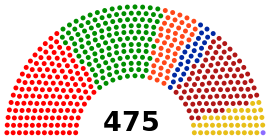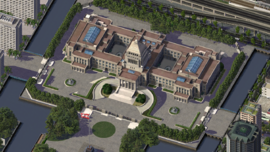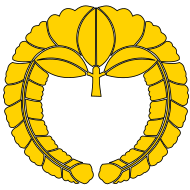House of Commoners of Okaiken
| House of Commoners 衆議院 Shūgiin | |
|---|---|
| The 58th House of Commoners | |
 | |
| Type | |
| Type | |
| Leadership | |
Prime Minister | |
Opposition Leader | |
| Structure | |
| Seats |
475 |
 | |
Political groups |
(by party as of Jul. 2016) SCP (140)
PPO (130)
OSP (47)
SDP (25)
Opposition (173): LDP (92)
Kōmeitō (NKP) (42)
Kei Yamada and friends (2) |
| Elections | |
| Direct Party and Representative Voting System (475 seats) | |
Last election | July 25, 2016 |
Next election | To be announced |
| Meeting place | |
 | |
|
The House of Commoners Building Okami, Okaiken | |
| Okaiken |
 This article is part of the series: |
|
|
|
Constitution
Judiciary
Prefectures
Elections
Foreign relations
|
|
Other countries · Atlas Politics portal |
The House of Commoners (衆議院 Shūgiin) is the lower house of the National Diet of Okaiken. The House of Officers is the upper house.
The House of Representatives has 475 members, elected for a four-year term. All 475 seats are determined by the Direct Party and Representative Voting System, a form of proportional voting.
The House of Commoners is the more powerful of the two houses, able to override vetoes on bills imposed by the House of Officers with a two-thirds majority. It can be dissolved by the Prime Minister at will, the most recent was by Toshiro Kurosawa on April 15, 2016.
Right to vote and candidature[edit | edit source]
- Sanese nationals aged 18 years and older may vote.
- Sanese nationals aged 22 years and older may run for office in the lower house.
Differences between the Upper and Lower Houses[edit | edit source]
The House of Commoners has several powers not given to the House of Officers. If a bill is passed by the lower house (the House of Commoners) but is voted down by the upper house (the House of Officers), the bill is considered declined and sent back to the committee. However, in the case of treaties, the budget and the selection of the prime minister, the House of Officers can only delay passage, but not block the legislation. As a result, the House of Commoners is considered the more powerful house.
Members of the House of Officers, who are elected to a maximum of four years, sit for a shorter term than members of the House of Officers, who are elected to full seven-year terms. The lower house can also be dissolved by the Prime Minister or the passage of a nonconfidence motion, while the House of Officers cannot be dissolved and takes over the temporary, but limited, position in passing laws during a dissolved parliament. Thus the House of Officers is considered to be more sensitive to public opinion, and is termed the "lower house".
Current composition[edit | edit source]
| "In-house group" | Representatives | |
|---|---|---|
| Sanese Communist Party (Okaiken Kyōsantō) | 140 | |
| Progressive Party (Shinpotō) | 130 | |
| Liberal Democratic Party (Jiyūminshutō) | 91 | |
| Socialist Party (Okaiken Shakaitō) | 47 | |
| Komeito (Kōmeitō) | 41 | |
| Social Democratic Party (Shamintō) | 25 | |
| Kei Yamada and friends (Yamata Kei to Yūjintachi) | 1 | |
| Total | 475 | |
- ↑ House of Commoners: Strength of the In-House Groups in the House of Commoners (Sanese version that additionally contains a list of Representatives sorted by group and by represented region: 会派名及び会派別所属議員数)